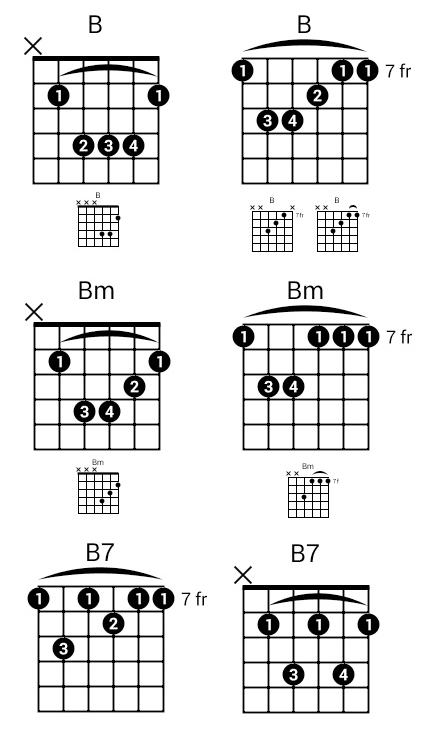To play the Major B guitar chord, you have a few different options. Here are two common fingerings
Option 1 – Barre Chord:
This version of the B chord is a barre chord, which means you use one finger to press down multiple strings.
- Place your index finger (1st finger) flat across all the strings on the 2nd fret. This is like creating a “mini bar” across the fretboard with your index finger.
- Now, position your other fingers as follows:
- Middle finger (2nd finger): Press down the 4th string (D string) on the 4th fret.
- Ring finger (3rd finger): Press down the 3rd string (G string) on the 4th fret.
- Pinky finger (4th finger): Press down the 2nd string (B string) on the 4th fret.
Ensure that your index finger is pressing down firmly and evenly across all the strings to get a clean sound. Some people find it helpful to slightly angle their index finger so that it presses down more on the higher-pitched strings (closer to the floor) and less on the lower-pitched strings (closer to the ceiling).
Option 2 – B7 Chord (Simplified):
This is a simplified version of the B major chord, and it’s easier to play for beginners or those who find the barre chord difficult.

- Place your index finger (1st finger) on the 1st fret of the 1st (high E) string, barring only that string.
- Use your middle finger (2nd finger) to press down the 2nd fret of the 5th (A) string.
- Use your ring finger (3rd finger) to press down the 2nd fret of the 4th (D) string.
- Let the 3rd, 2nd, and 1st strings ring open (unfretted).
Strum from the 5th string (A string) down to the 1st string (high E string), avoiding the low E string. This will give you a B major chord.
Keep in mind that the B major chord can be challenging for beginners due to the barre chord shape and the finger strength required. Practice regularly and be patient with yourself as it may take time to build the necessary finger strength and dexterity.
Sure, here are the steps on how to play the B major guitar chord
- Place your index finger on the 2nd fret of the A (5th) string.
- Place your middle finger on the 4th fret of the D (4th) string.
- Place your ring finger on the 4th fret of the G (3rd) string.
- Place your pinky on the 4th fret of the B (2nd) string.
- Strum all six strings.
Here is a diagram of the B major chord:
E A D G B E
2 4 4 4 4 2
The B major chord is a barre chord, which means that you use your index finger to barre across all six strings at the 2nd fret. This can be a difficult chord to play at first, but with practice, you’ll be able to get it down.
Here are some tips for playing the B major chord:
- Make sure that your fingers are pressing down firmly on the strings.
- Keep your fingers close to the fretboard.
- Practice strumming the chord slowly at first, and then gradually increase your speed.
With a little practice, you’ll be able to play the B major chord like a pro!
Here are some other ways to play the B major chord:
- You can play the B major chord in the 7th position by placing your index finger on the 7th fret of the E (2nd) string, your middle finger on the 8th fret of the G (3rd) string, your ring finger on the 9th fret of the A (5th) string, and your pinky on the 9th fret of the D (4th) string.
- You can also play the B major chord as a power chord by placing your index finger on the 2nd fret of the A (5th) string and your ring finger on the 4th fret of the D (4th) string.
Experiment with different ways to play the B major chord and find the one that works best for you.
More Lessons Click Here
Can I Learn Guitar in 6 Months
Yes, you can learn guitar in 6 months.
If you are just starting out, I recommend that you focus on learning the basic chords and strumming patterns. Once you have mastered these basics, you can start learning more advanced techniques, such as fingerpicking and soloing.
Very helpful for us beginners from Zambia
thank you